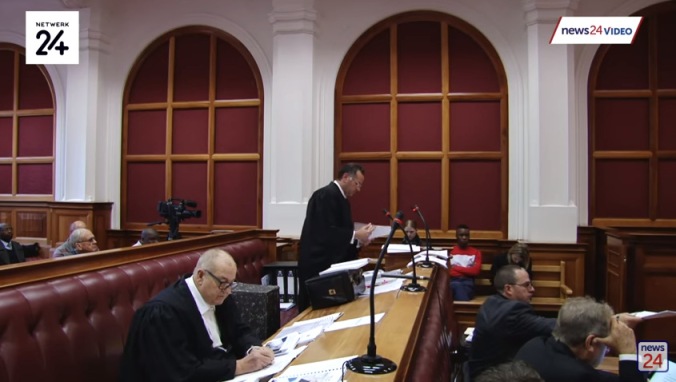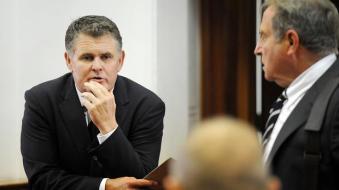Today on the Winter Solstice, the longest day of the year, Dr Reggie Perumal’s interminable time on the stand came to an end. I personally sat in on the state pathologist’s testimony on October 12, an experience that shook me. I sat in again on some of Perumal’s testimony-in-chief, such as it was, in the first week of June 2018.
I must admit, I found the epilogue of Perumal’s testimony-in-chief mindnumbingly dull, and actually left court a few minutes before the adjournment to make a few important calls.
The prosecutor also took a timeout in his cross-examination of Perumal, allowing the defence to field another expert witness, Dr. Peter, whose evidence was subsequently thrown out by the defence. This caused the defence to lose a lot of momentum, and allowed the prosecutor to catch up. It meant the prosecutor could focus all his time analyzing one Mount Everest of information instead of having to wage an assault on two simultaneously.
It’s easy to miss, but Louis van Niekerk is working on his own, effectively, he has no legally qualified sidekick to delegate his work to as Galloway did, whereas Van der Spuy has at least one other lawyer – Tony Mostert – to assist him.

Van Niekerk, I’m assuming, also has other cases to attend to. If Van Niekerk doesn’t have other legal counsel to rely on, it doesn’t mean he’s not getting any assistance. My fellow true-crime author Thomas Mollett has been in court actively providing valuable if anonymous support and insight, listening in on the evidence, taking notes and studying the autopsy evidence. Thomas hasn’t attended every day of the trial [neither have I], but I’m pretty sure he’s been at Van Nieker’s right hand on all of the day’s the pathology evidence was fielded [by both pathologists].




The exit of Dr. Peter was a mercy; a stroke of good luck to the prosecution, but that still left him with a mountain to climb. Where to start? Where to stop?
In retrospect, we can see there was a pattern, a strategy to Van Niekerk’s cross-examination. He would examine a tranche of evidence, and then dip into Perumal’s CV, causing him to be a little more circumspect in his criticisms of Khan. Then he’d deal with another aspect of autopsy evidence, not speculatively but by having photos showing what was being put to him [and to the court], and then Perumal would have to make a reasonable comment about it. And then Van Niekerk would hit him with something else from his portfolio of cases.
To be honest, I didn’t like the stop-start quality of the interrogation, it felt messy at times, but court isn’t about entertainment value; if you’re a prosecutor, it’s about getting an witness to concede on as many issues as you can. And Perumal did. Getting a hired gun to concede on anything ought to be like pulling teeth. If you search the #Rohde “Perumal concedes” and #Rohde “Perumal agrees” hashtag-search-term combination, there’s precious little there. And yet Perumal did concede.
I was gobsmacked at just how often and on the crucial evidence Perumal conceded. Van Niekerk vs Perumal was at times like watching someone take candy from a baby. To recap, Perumal conceded that:
- He couldn’t be certain about Susan’s cause of death.
- He admitted the noose was loose, contradicting his client.
- He admitted the possibility that Susan’s body was dragged into the bathroom.
How did he do it?
Van Niekerk’s beside manner, if that’s the right expression, meant he was firm, but didn’t antagonise the witness unduly. Cross-examination is a dance. Neither party likes what the other party is doing, they have different agendas, so both try to make little concessions to make one another’s life easier. The expert can be a little more yielding [“not dogmatic”] on his opinions, and the prosecutor can go easier on him where he contradicts himself, or on issues of his credibility. Like this one:
And this one:
Van Niekerk left these gut punches for the very end, just as he only accused Rohde of lying right at the end of his testimony.
Van Niekerk could have drilled Perumal very hard on this, and yet he simply brought it up, let Perumal comment, then moved on. What was he doing? I think it was a shot over the bow, firstly to soften the pathologist, and also to inform [or warn] the court that things spoken weren’t always necessarily quite what they seemed.
The other thing to bear in mind, and in this area Gerrie Nel made an error, is the personality of the Judge. A certain style of confronting a witness may aggravate a Judge, and in the Rohde case, the Judge does seem to prefer a gentler approach. The same came be said for Judge Desai. Although he’s affable, he can be quite strict, and prefers a gentle tone from his court. It’s important for prosecutors [and defence advocates] to abide by the tone and timbre of the court, if they wish to be given a little extra legroom. We can see Van der Spuy has gradually been loosing this contest, while Van Niekerk has advanced into her good graces.
Still, whether Van Niekerk punched the concession out of him, or took it like candy from a baby, Perumal conceding that the noose was loose is a huge breakthrough for the state. It directly contradicts Rohde’s version on a crucial aspect of the case.
I don’t want to blow up the cross-examination too much. If anything, Perumal left a lot of residual doubt, and that’s actually his job. Not to provide certainty, but to provide expert testimony about how uncertain everything is. So his concession that Susan’s time of death is uncertain is not really something to crow about, is it? Admitting that there are many possibilities doesn’t necessary amount to a concession, but to a broad reinforcement of the uncertainty surrounding aspects of evidence.
To Perumal’s credit, he wasn’t hired to testify in the Pistorius case because it was thought his post mortem findings supported the state’s case. There may have been another reason as well. Perumal may have felt walking a tightrope as a hired gun [if that’s what he is] was too risky under the lazer-scrutiny of the media in such a high-profile case. Perhaps that’s why he dodged the Van Breda trial as well. In the Rohde case, he was committed, and the media attention [via the livefeed] came along just before his testimony. Then it was too late to duck, assuming he wanted to.
In my view, it’s important that courtroom players see value in the court narrative. That’s what it is. It’s important to start and end well, and Van Niekerk did in his cross-examination.
I know what you’re thinking. As a professional narrator I would say that. But think about it like this: if you’re scoring a lot of little hits but boring your audience to tears, a lot of those hits miss the mark simply because your audience has tuned out. That’s what happened in the Pistorius trial. As Gerrie Nel pontificated endlessly about the duvet being on or under a pair of jeans, and electric cords here or there, pundits wondered then whether the Judge was a Sleeping Giant, or sleeping through some of the mind-numbing minutiae. We know how that turned out.
In the O.J. Simpson case, the DNA evidence went over the jury’s heads. The mountain of evidence was all valid, and devastating to the defence, but the jury weren’t scientists, and ultimately for them it was much ado about nothing.
In the end, the prosecutor and the defence lawyer are playing to an audience of just one: the Judge.
Arguably the defence lawyer is also playing to his client, satisfying the man paying the bills that his case is being fielded in a compelling fashion [even when it seems dubious and indefensible right off the bat to everyone else].

For a long time during the Oscar Pistorius trial, Barry Roux seemed to be showing up to build a house of cards. It seemed to be more about the appearance of a defence than an actual defence. That’s what it felt like for me, but it wasn’t like that for everyone. Many people were drawn in by his defence, many people were ultimately fooled, including the Judge. Ultimately, Pistorius’s defence – the way he explained it to the TV cameras, and how it devolved in court – was just that, the appearance of a defence. The imaginary burglar was an apparition Oscar expected us to accept because he was Oscar. Appearances cannot survive the test of scrutiny, and credibility is true crime’s core value.
Test an appearance for long enough, cross-examine in sufficient detail, and a charade crumbles to dust. A liar’s greatest trick is counting on the deceived’s lack of attention. A murderer relies on lack of attention even more, but also uses tricks like staging, covering up, play acting and deception to make his schema stick. When everyone is watching, the game is revealed. I think that’s starting to happen now in this trial.




Pingback: Jason Rohde Trial: Live Coverage and Analysis #tcrs | True Crime Rocket Science / #tcrs